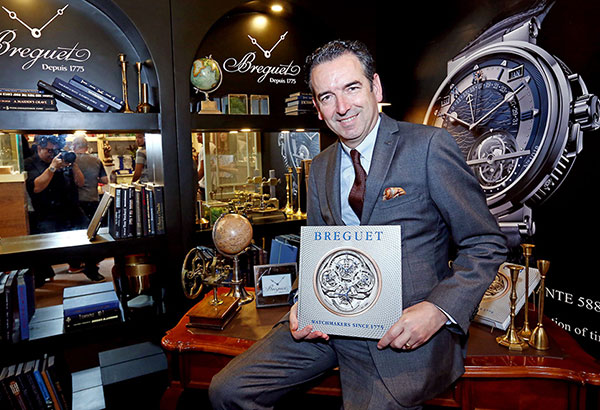Horology & the remarkable history of Abraham-Louis Breguet


Historian Emmanuel Breguet during the Manila launch of his book Breguet Watchmakers Since 1775: The Life and Legacy of Abraham-Louis Breguet, second edition Photo by Ramon Mangila
Historian and author Emmanuel Breguet comes from a family of watchmakers and inventors. He is a seventh-generation descendant of company founder Abraham-Louis Breguet, watchmaker to kings and inventor of the self-winding watch, the gong spring and enameled dial, among many others.
He also comes from a family of aviators. His grandfather was a pioneer in French aviation, a field that his ancestors “explored when my family sold the company a long time ago.”
As a Breguet and a historian, it is this rich heritage of innovation that makes Emmanuel’s job at Breguet a joy to him. “It’s a dream for me to work for Breguet. When I joined in 1993, I was appointed to write the history of the company.”
A graduate of Sorbonne, he has dedicated himself to the work of Abraham-Louis Breguet and is today vice president in charge of patrimony and strategic development for Montres Breguet. As custodian of the brand’s heritage, he cares for the exceptional body of archives of Breguet.
Emmanuel was in Manila at the end of October to launch the second edition of his book Breguet Watchmakers Since 1775: The Life and Legacy of Abraham-Louis Breguet during the art fair Nonesuch: Fine Collectibles and Rarities. The fair was organized by Trickie Lopa, Lisa Periquet and Dindin Araneta, the women behind the Art Fair Philippines.
Lucerne Group managing director Emerson Yao — a patron of the arts and the annual Art Fair — saw the Nonesuch fair as the perfect venue to launch Emmanuel Breguet’s book in the Philippines.
Indeed, when you’re talking about Breguet and the watches they have produced through 242 years, every single piece is a collectible. Napoleon Bonaparte was the first buyer of Breguet’s travel clock, and Naples Queen Caroline Murat wore Breguet’s first wristwatch.
Emmanuel published the first edition of his book 20 years ago, in 1997, and the book instantly became a classic among horology enthusiasts. It is a narrative that enables readers to discover the life and work of his brilliant ancestor, charting his rise from humble beginnings to become a great inventor, artist, entrepreneur and watchmaker to royalty.
The engrossing narrative also connects to today’s company, Montres Breguet, and a dedicated chapter pays homage to the late Nicolas G. Hayek, CEO and president of Breguet and the visionary founder of parent company, the Swatch Group, who headed the brand from 1999 to 2010.
Abraham-Louis Breguet, considered the Father of Modern Horology, was born on Jan. 10, 1747 in Neuchatel, Switzerland and it would be in Paris where he would make his name.
Emmanuel writes of Paris, 1775, “The city in which Voltaire was soon to expire and the young Mozart would shortly arrive presented fertile ground for the encouragements and success of artists and craftsmen of genius. This was the Paris in which a young watchmaker, who already knew the city well and whose name betrayed his Swiss origins, decided to set up his business. It was a move which was to mark the beginning of a brilliant career that would take watchmaking and clockmaking to new heights of perfection, and the end of a journey — through different lands, ideas and social strata — which had started 28 years earlier in the cold of a Swiss winter on the shores of lake Neuchatel.”
Breguet married a young Parisian, Cecile-Marie-Louis Lhuillier, whose father was a member of the Parisian bourgeoisie. They would have one son, Antoine-Louis, and lose two children. By the time he was 33, Breguet also became a widower.
“Overshadowed as it was by mourning, the period 1775 to ’80 also marked the beginnings of Breguet’s professional success, as he had just achieved his first goal, the development of perpetuelle — later known as ‘automatic’ — watch, after many years of intensive research work,” writes Emmanuel.
He began making watches for King Louis XVI and Queen Marie Antoinette, who would be his customers for life along with other royals including the Prince of Wales, the Prussian King, George IV, and many diplomats.
Among Breguet’s inventions, his “dual-style chronometer No. 45 without the most complex precision ever made, with both duodecimal and decimnal systems. The dial displays simultaneously the time, as well as the Gregorian and Republican calendars. This unique timepiece belonged successively to the Duc de Praslin and Mgr Belmas, two of Breguet’s most outstanding clients , with a fascination for the most extraordinary mechanisms.” He once threw a watch to the ground to observe if it would still work (it did).
The rest of Emmanuel’s book narrates both the innovations of his ancestors tied with the changing political and social climates of the time. It’s not only a history of the Breguet watchmakers — Abraham-Louis Breguet, Antoine-Louis Breguet and Louis-Clement — and the company to the present, but it’s also a history of horology itself.
It’s a beautiful volume of passionate inventors and modern watchmaking.
* * *
Visit the author’s travel blog at www.findingmyway.net. Follow her on Instagram and Twitter @iamtanyalara.
Breguet is available at Lucerne boutiques in Glorietta 4 and Shangri-La Plaza Mall.



















